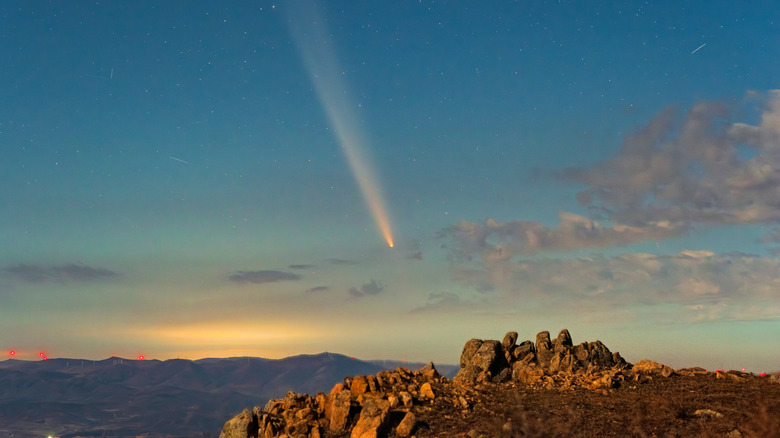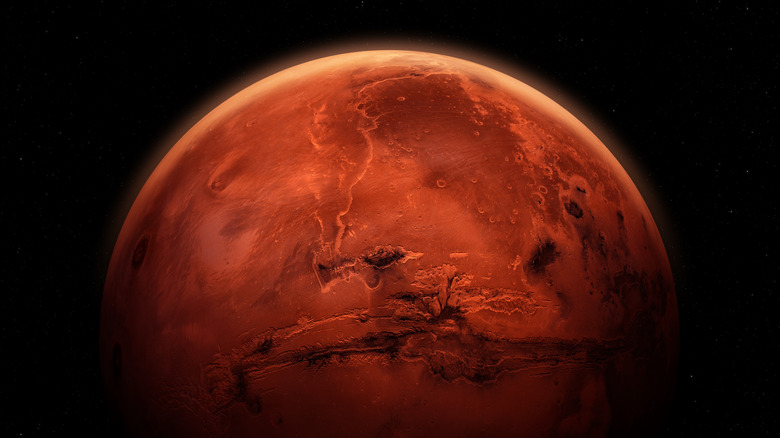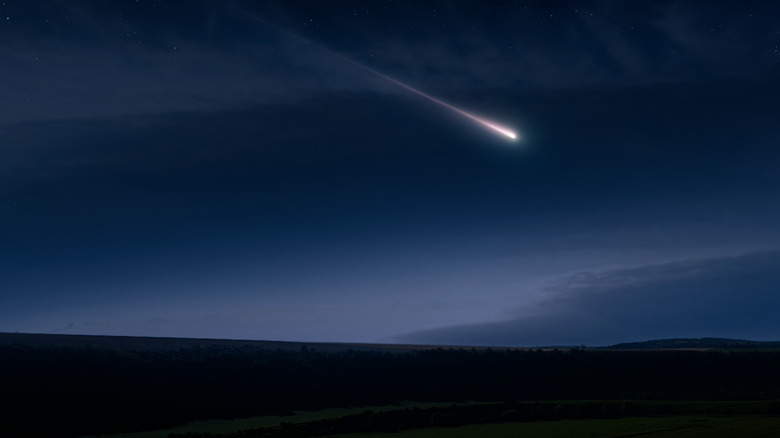The Biggest Meteorite From Mars Just Sold For A Ridiculous Amount Of Money
As mysterious as large parts of our solar system are, we're learning more and more about Mars all the time. As it turns out, the red planet has quite a lot in common with Earth, and is of particular interest as a potential home for the future human race. Companies like SpaceX are working towards establishing a self-sufficient city on the red planet and with plenty of grim predictions about the end of the world going around, it's not hard to see why we might be so invested in setting up an off-world colony — especially on a planet that could hold an exciting secret within its ice that suggests life might have once existed on its surface.
For now, though, we're still in the exploration phase, and thus far Mars is one of the most explored planets in our solar system. Sometimes, though, the fourth planet from the sun helps us out by sending pieces of its surface to Earth.
A surprising amount of meteoritic material falls to Earth (roughly 48.5 tons per day — 95% of which burns up in the planet's atmosphere). Pieces of debris that do make it all the way through and land on Earth's surface are known as meteorites, and so far there have been more 50,000 meteorites discovered, 99.8% of which come from asteroids. The other 0.2% originate from the moon and Mars and thus far we've identified around 400 Martian meteorites. These small pieces of our neighboring planet were thrown into space by meteoroid impacts and are extremely rare and unique. It's no wonder, then, that the largest ever meteorite from Mars has now sold for an incredible price.
The multi-million dollar Martian meteorite
Ever since NASA's Mariner 4 spacecraft flew past Mars on June 14, 1965 and captured the first ever space-based photographs of another planet, experts have made all sorts of strange discoveries on Mars, from tiny Martian flowers to tornadoes. Such discoveries have only been possible as a result of incredible engineering and scientific feats, with NASA's Perseverance rover and Mars Reconnaissance Orbiter offering new insights into this fascinating world. But it's also incredibly helpful when Mars comes to us instead, and so far we've had several meteorites which have revealed much about the red planet.
None have been quite so impressive, however, as NWA 16788 (with NWA standing for Northwest Africa, the region in which the rock was discovered), which is the largest known piece of Mars ever to make it to Earth. The remarkable piece of Martian rock was sent hurtling to Earth after a massive asteroid strike, which projected the meteorite 140 million miles through space to land in the Saharan desert. You might expect such a rare find to fetch a decent price, but $5.3 million? That's a lot of money for a rock. That is, however, exactly how much NWA 16788 sold for after an anonymous bidder won the lot at a 2025 Sotheby's New York auction.
The incredible specimen was found in November 2023 by a meteorite hunter in the remote Agadez region in northern Niger. Not only is the meteorite a rare example of Martian rock that made its way to Earth's surface, it also happens to be the largest such object, weighing 54 pounds. That might not seem all that massive but compared with other meteorites from the red planet, it's positively gigantic. NWA 16788 is 70% larger than the next largest Martian rock found on Earth and as such, makes up around 6.5% of all Martian material in human possession.
The rarerst of the rare meteorites
Details about NWA 16788 were published in the 113th edition of the Meteoritical Bulletin. The specimen's reddish-brown fusion crust clearly advertises its origin as a piece of the Martian landscape, but the rock also contains glass known as maskelynite, which is thought to have been created when the asteroid first struck Mars and threw NWA 16788 into space, transforming the feldspar minerals into glass via intense heat and pressure.
A small piece of the meteorite was sent to Shanghai Astronomy Museum for identification, which revealed NWA 16788 to be an olivine-microgabbroic shergottite, composed of pyroxene, maskelynite, and olivine. This microgabbroic type of Martian meteorite is rare in and of itself, making this a sought-after piece. Another unique aspect of NWA 16788 is fact that it appears to have minimal signs of weathering, suggesting it arrived from space relatively recently. All of which almost certainly contributed to the $5.3 million total that was paid (the most ever shelled out for a Martian meteorite). For comparison, another Martian meteorite sold at auction for $200,000 back in February 2021.


